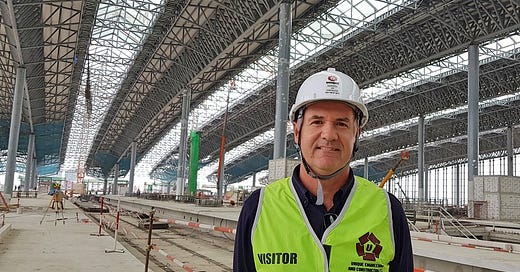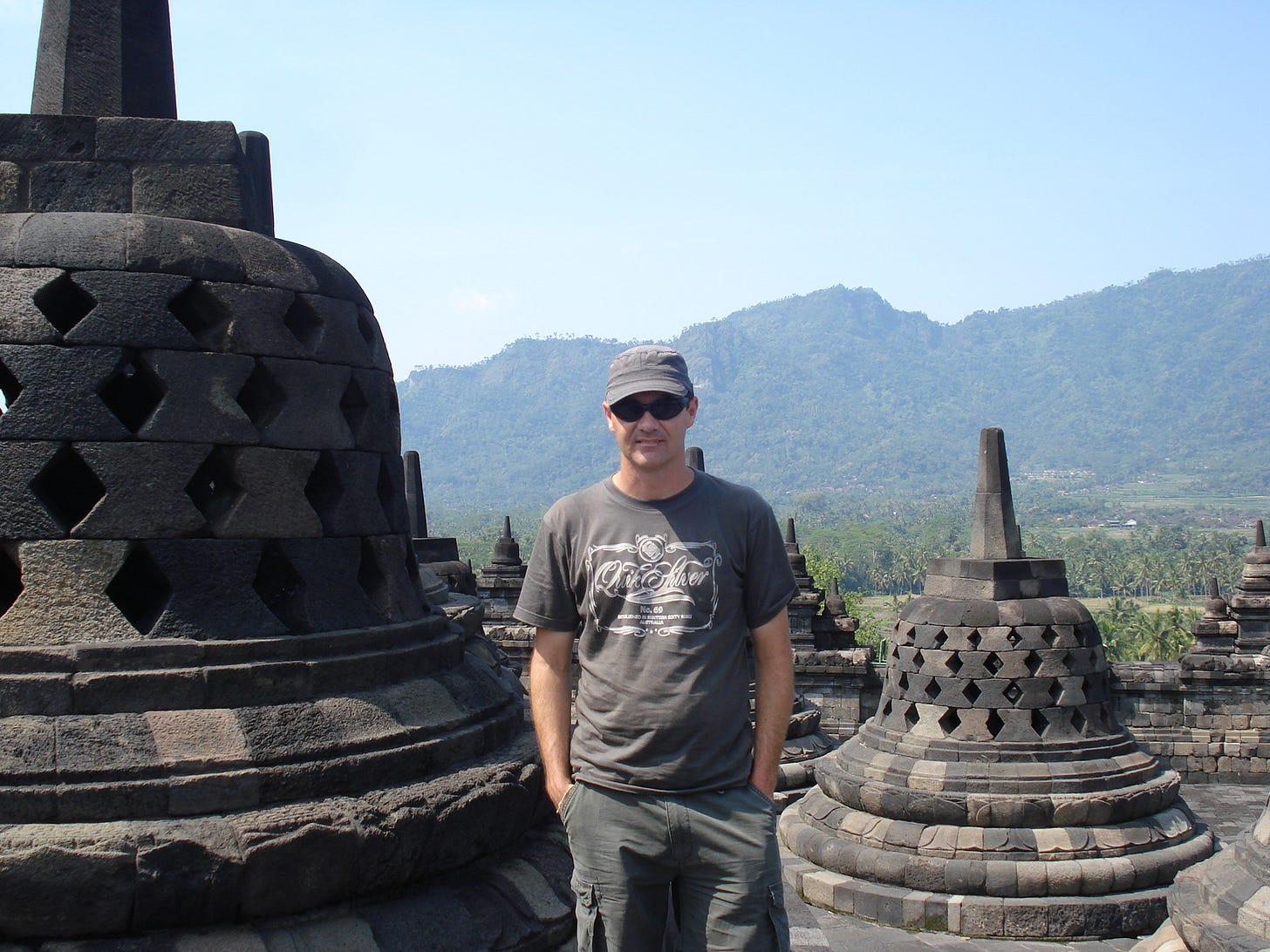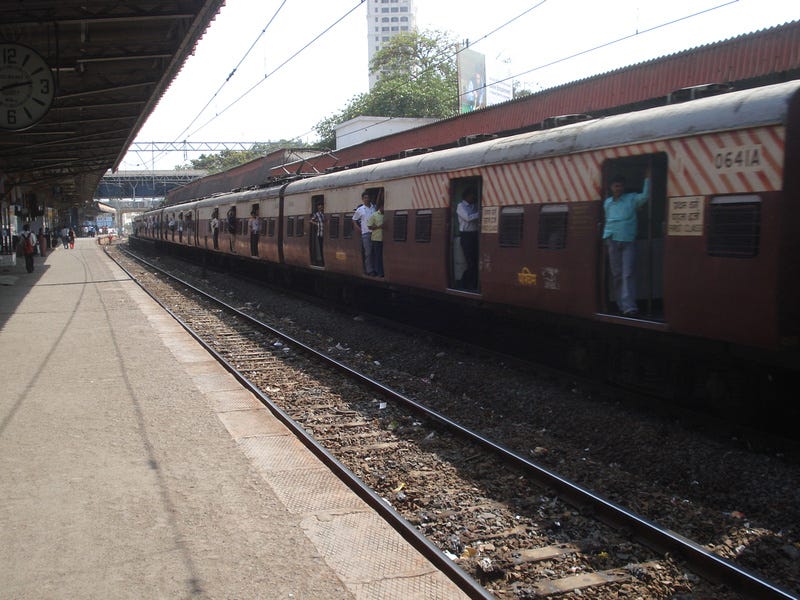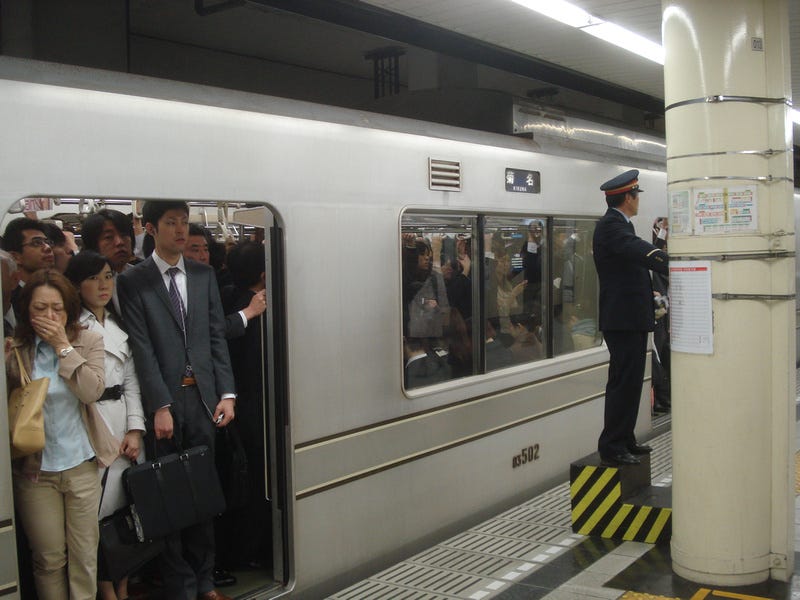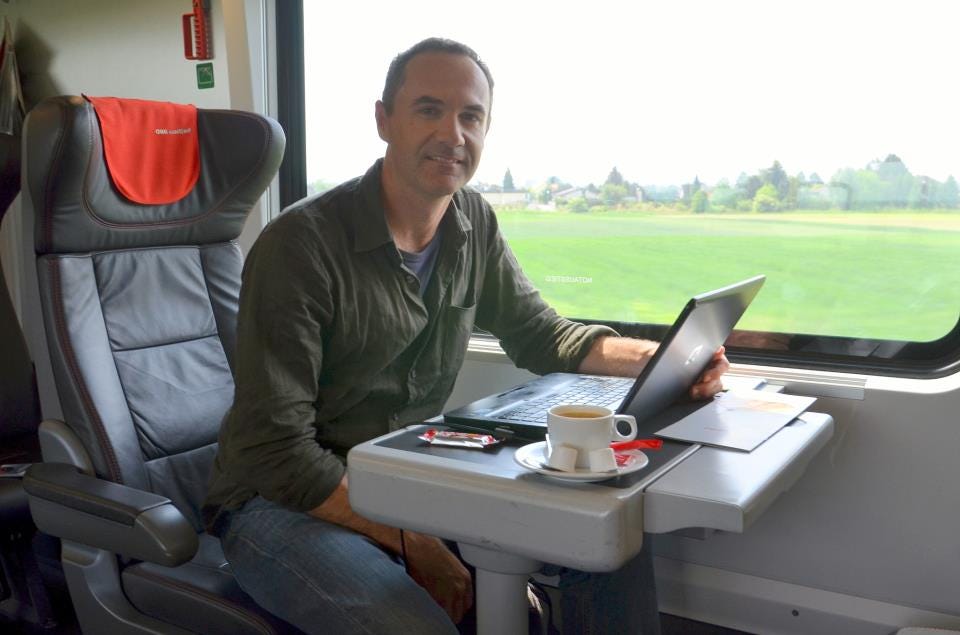The Futurist
Meet James Clark, a digital nomad long before that became a thing, and the author of Future Southeast Asia, a website dedicated to revealing where the region is headed
Though we've never met in person, I've followed James Clark from afar via his superb newsletter and website, Future Southeast Asia. In a nutshell, it's an ongoing guide to new development and infrastructure across the region, consisting of his own well-researched pieces on projects of interest, as well as a curated set of links that lead readers down the rabbit hole that is the planned projects that may never even happen (but would be so cool if they did). I recently caught up with James to find out what is driving him on this one-man mission to keep track of construction in Southeast Asia.
You come from Melbourne. What was your childhood like?
I’ve spent most of my Australian life in Melbourne. As a child, we moved around the eastern states before settling on a farm in western New South Wales. I honestly had the best of both worlds by experiencing a city and country upbringing.
Did your family travel? What sort of trips would you take?
We were a typical 1980s Australian family that would take an annual road trip to Queensland. These trips would take around two to three days on their own, so that was also a part of the holiday experience.
There were no low-cost airlines in those days, so overseas trips wasn’t a normal thing for most Australians. I went on my first overseas trip in 1995 when I was 23, which is probably old by today’s standards. That was a one-week trip to Hawaii, and it was on this trip where I got the international travel bug.
When and why did you decide to live your life on the road?
It was more of a gradual transition, and not a conscious decision. I took a seven-week trip to the US in 2006, and that barely sated my wanderlust. After that I thought the best way to spend an extended time abroad is to work, so I applied for the two-year UK working holiday visa in 1999.
I returned to Australia after that but I still wanted to live abroad and travel, so I applied for a one-year working holiday visa in Ireland in 2002. It was during this time that I started publishing commercial travel websites. I was doing this part-time while working various day jobs. I learned about basic HTML, search engine optimisation (SEO), and affiliate marketing. This started out as a hobby, but it soon became apparent that it could become a full time business that could be done from anywhere.
My Irish visa expired in 2003, and by then I was starting to make income online. I didn’t realise it at the time, but I had become a digital nomad. I love the online publishing business and the fact that I can travel anywhere, anytime, so I have never considered stopping.
For you what are the major challenges of day-to-day life as a ‘location independent entrepreneur’ aka digital nomad?
I don’t feel there are major challenges, but I am coming from a position where I gradually eased myself into this weird life. My challenges are more work-related than anything. I don’t really see the point of complaining about a lifestyle that I have self-imposed on myself. I also acknowledge that as a holder of an Australian passport I have a level of privilege that many of my friends from other countries don’t have.
You began blogging with Nomadic Notes, what was that?
My publishing business began in 2003, but these sites were purely informational travel guides that didn’t have my name attached. This was before the age of social media, so I didn’t have an online presence where people could find me.
Things started noticeably changing in 2007. This was the year that the iPhone was released, and the publication of The 4-Hour Workweek by Tim Ferriss. I compiled a digital nomad history that shows the rise of digital nomad culture, and it was around this time that I started running into more ‘people who work from cafes with their laptops’ (as we used to call ourselves).
I launched Nomadic Notes in 2009. I started writing about my travels as a digital nomad, and it became a useful way to be found online by other nomads.
The site is a general travel blog, which most blog experts these days will tell you not to do! If you are looking to stand out then you should blog about a niche subject rather than a general topic. This wasn’t my main money site though, so I could afford for it to be a general travel blog. I also didn’t know exactly what I wanted to write about either, so the best way to find out is to just start writing. It was writing about ideas that led me to Future Southeast Asia.
Do you have any training or writing experience, or are you completely self-taught?
I’ve always enjoyed writing to friends, but before the internet I never entertained the thought that it would become part of a business I’m involved in. My main interest in publishing has always been the compiling of information into usable guides. The only time I thought of being a writer before the internet was writing for Lonely Planet. Now I am an online guide writer.
You're now living in Saigon, what led you to decide on that city as the place to base yourself? And were there any other contenders (and why didn't you choose them instead)?
Like my life on the road, this was also a gradual transition instead of a concrete decision. My first visit to Saigon was on a backpacking trip in 2005. I didn’t consider it as a base at that point, and I was spending more time in Thailand after that.
An online friend who moved there made the case for living there, so I revisited for a month in 2012. In the seven years that I had last visited, the city had changed considerably. I kept returning for longer stays while still travelling around Southeast Asia, and then the next thing you know I was spending more time there than anywhere else.
I had a back injury in 2016 which slowed down my travels. I have a good back specialist in Saigon, so I stayed there while I recovered. And then in March 2020, I arrived back in Saigon after a trip and the borders closed three days later. I was lucky to spend the rest of 2020 in Vietnam, where they managed to keep the virus in check. I was able to travel around Vietnam in this weird bubble while most of the world had stringent travel restrictions. I ended up spending over 17 months in Vietnam, which is the longest I have been in one single country since I started this expat life in 1999.
Although you're a confirmed digital nomad, at any point did you actually have an apartment and pay rent and bills?
At this moment in time I am a full-time digital nomad with no fixed address. I did have a room that I rented in Saigon up until August 2021, and I was paying rent there while travelling around. After being grounded for so long I am now going to travel around for a while. I am also extra motivated to do more on-the-ground research of provincial cities across Southeast Asia, so I expect to travel more post-pandemic.
I have gone though periods of renting rooms since becoming a digital nomad in 2003. I rented a cheap room in a house with friends in Melbourne from 2003 to 2009, and I would stay there for half of the year. That was the longest I have rented in one place.
Let's talk now about Future Southeast Asia - what is it?
Future Southeast Asia was a gradual idea that formed from my writing at Nomadic Notes. I found that I was writing more about travel-related construction and transport projects. There were also other subjects I found myself researching that weren't on the theme of travel, so it was time to start a new site that was completely dedicated to the subject of construction, transport, and infrastructure across Southeast Asia.
I also started this site because it is something I personally wanted to read about but couldn’t find anything like it. This is advice I would give to any new website in general (especially about travel). Either write about something that hasn't been written about before, or write about about a place from a completely new angle. Don't just start another travel website with ‘the top 10 things to do in Siem Reap’. Instead, find an interesting story about something or someone in Siem Reap.
My articles are sometimes questions I ask myself that need answering. For example, after spending years in Vietnam watching Hanoi and Ho Chi Minh City slowly (very slowly) build their first metro lines, I thought: ‘How slow is it really?’. So I made a comparison of cost and construction times of first metro lines in Asia (and in Hanoi's case it was actually very slow).
I like making maps as well, and the first map I made for Future Southeast Asia is a futuristic map of an expanded Ho Chi Minh City Metro. This map includes all proposed lines, plus extra lines I think should be built. I call this map. ‘If Saigon had a subway like Shanghai’.
Why did you choose to focus on Southeast Asia as a region?
When I became a full-time nomad after living in Ireland, I was spending most of my time in Europe. I started a Rail Europe site as I enjoyed travelling by train there, but I didn’t get into the infrastructure side at that point. After a few years of nomadding I started spending more time in Southeast Asia, and I found myself wishing there was a train system in Southeast Asia like I’d found in Europe. It was after a gruelling 17-hour overnight bus trip in Laos on a terrible road that I wondered if there has ever been a railway proposed for this part of the world. That lead me down a rabbit hole researching every proposed railway in Southeast Asia. I made a map showing current and proposed railways which I published on Nomadic Notes.
This map is an update of a Southeast Asia subway-style map I made the year before.
I did consider making it a broader site covering all of Asia, but I would have been spreading myself too thin by covering more countries. I decided to focus on becoming an expert in Southeast Asia, but I still have an outlet at Nomadic Notes to write about travel-related projects elsewhere. For example, I wrote about the Hong Kong-Zhuhai-Macao Bridge when I visited Hong Kong in 2018.
Is there a particular city or place that really fascinates you?
I’m fascinated by most places, which still keeps me travelling today. For this question though, I immediately thought about two cities that I visited about two months apart from each other in 2007. It was these two cities that awakened the transport and infrastructure nerd inside me. Those cities were Mumbai and Tokyo, which are two megacities of at least 20 million people. These two cities could not be further apart from each other in terms of infrastructure, and I was fascinated by both of them.
I visited Mumbai on what was my first trip to India. I spent a week there, but I would have happily spent the rest of the month there. Tokyo was a five-day stopover, where I also would have gladly stayed longer. I should have picked up the signs that I was a transport nerd on those trips. Instead of seeing whatever was recommended in guide books, I wanted to see the famous overloaded trains of Mumbai, and the subway of Tokyo where the guards push people into the packed peak-hour carriages.
How has the website and newsletter evolved and changed?
Future Southeast Asia started out in 2018 under the name Living In Asia. This was on an old domain that I wasn’t using, so I figured I should use it to publish articles about construction there instead of on Nomadic Notes.
I didn’t have a publishing schedule or regular newsletter at that point. I was just posting articles when I was researching something out of my own interest.
By April 2020 it was apparent that my travel publishing business was going to be out of action for the rest of the year. Traffic to Nomadic Notes dropped like a stone, and commissions from hotel bookings dried up overnight.
I was in Saigon in April 2020 and we went into a lockdown that month. My pandemic project was to make Living In Asia my main website. It was also around this time that saw the rise in popularity of newsletter publishing with paid subscriptions.
I moved my newsletter and set up an option for paid subscriptions to help support the site. This also gave me an incentive to post a weekly article on the site, and post a weekly newsletter that includes a roundup on news about transport and construction in Southeast Asia.
After a year of consistent posting it was apparent that the name of the site was confusing. I had initially used that domain to write guides for living in cities in Asia, and people were arriving on the site looking for such guides. In March 2021 I rebranded to Future Southeast Asia.
You mention on your site about being available for speaking at conferences and events about rail projects. Has running Future Southeast Asia opened any new doors for you?
Oh, I forgot about that. I went to a rail conference in September 2019 where my site was an advertising partner. After that conference, I put a notice on the site that I am available for conference talks. You all know what happened a few months after that, so I haven’t thought much about live events with large groups of people since then.
I have been getting messages from readers who work for government organisations and construction companies, so I look forward to being able to attend conferences in the future.
At one of the Bangkok railway conferences I got to visit the worksite of the Bang Sue Grand Station, so I would like to do more visits like that in the future so I can publish construction updates.
You just turned 50 - are there any major insights that have come with that birthday?
The day ticked over and it felt like just another day, but a new decade does make you reflect more than other days. I turned 50 in Thailand, which offers a retirement visa for foreigners over 50. I’m nowhere near feeling like retirement though, and I feel like I need to be more urgent and deliberate in my work.
Last but not least, what are your predictions for the future of Southeast Asia?
I have been writing a lot about railway expansion in Southeast Asia, so I will focus on that. I think we will see a rise in regional travel as more rail lines open up. It will soon be possible to do short breaks from Bangkok to Luang Prabang by rail, and the East Coast of Peninsula Malaysia suddenly becomes a very easy trip from KL once the East Coast Rail Link opens.
Sign up for the Future Southeast Asia newsletter below:

